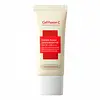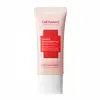What's inside
What's inside
 Key Ingredients
Key Ingredients

 Benefits
Benefits

 Concerns
Concerns

 Ingredients Side-by-side
Ingredients Side-by-side

Water
Skin ConditioningZinc Oxide
Cosmetic ColorantPropylheptyl Caprylate
EmollientC12-15 Alkyl Benzoate
AntimicrobialButylene Glycol
HumectantDisiloxane
Skin ConditioningLauryl Polyglyceryl-3 Polydimethylsiloxyethyl Dimethicone
Skin ConditioningIsododecane
EmollientIsotridecyl Isononanoate
EmollientPolyglyceryl-3 Polydimethylsiloxyethyl Dimethicone
Skin ConditioningCalendula Officinalis Flower Extract
MaskingDisteardimonium Hectorite
StabilisingMagnesium Sulfate
Triethoxycaprylylsilane
Methyl Methacrylate Crosspolymer
1,2-Hexanediol
Skin ConditioningPolyhydroxystearic Acid
EmulsifyingGlyceryl Caprylate
EmollientDipotassium Glycyrrhizate
HumectantCaprylyl Glycol
EmollientPolymethylsilsesquioxane
Ethylhexylglycerin
Skin ConditioningTocopherol
AntioxidantParfum
MaskingWater, Zinc Oxide, Propylheptyl Caprylate, C12-15 Alkyl Benzoate, Butylene Glycol, Disiloxane, Lauryl Polyglyceryl-3 Polydimethylsiloxyethyl Dimethicone, Isododecane, Isotridecyl Isononanoate, Polyglyceryl-3 Polydimethylsiloxyethyl Dimethicone, Calendula Officinalis Flower Extract, Disteardimonium Hectorite, Magnesium Sulfate, Triethoxycaprylylsilane, Methyl Methacrylate Crosspolymer, 1,2-Hexanediol, Polyhydroxystearic Acid, Glyceryl Caprylate, Dipotassium Glycyrrhizate, Caprylyl Glycol, Polymethylsilsesquioxane, Ethylhexylglycerin, Tocopherol, Parfum
Water
Skin ConditioningCyclopentasiloxane
EmollientZinc Oxide
Cosmetic ColorantHomosalate
Skin ConditioningEthylhexyl Salicylate
UV AbsorberCoco-Caprylate/Caprate
EmollientDipropylene Glycol
HumectantCaprylyl Methicone
Skin ConditioningTitanium Dioxide
Cosmetic ColorantLauryl PEG-10 Tris(Trimethylsiloxy)Silylethyl Dimethicone
EmulsifyingGlycerin
HumectantNiacinamide
SmoothingPhenyl Trimethicone
Skin ConditioningCitrus Aurantium Dulcis Peel Oil
MaskingOlea Europaea Fruit Oil
MaskingLavandula Angustifolia Oil
MaskingLilium Speciosum Flower Oil
MaskingOrbignya Oleifera Seed Oil
EmollientTocopheryl Acetate
AntioxidantDisteardimonium Hectorite
StabilisingMagnesium Sulfate
Methyl Methacrylate Crosspolymer
Vinyl Dimethicone/Methicone Silsesquioxane Crosspolymer
Dimethicone
Emollient1,2-Hexanediol
Skin ConditioningTriethoxycaprylylsilane
Stearic Acid
CleansingAluminum Hydroxide
EmollientSorbitan Caprylate
EmulsifyingDicaprylyl Carbonate
EmollientDimethicone/PEG-10/15 Crosspolymer
Glyceryl Caprylate
EmollientDimethicone/Vinyl Dimethicone Crosspolymer
Skin ConditioningEthylhexylglycerin
Skin ConditioningAdenosine
Skin ConditioningSodium Hyaluronate
HumectantBisabolol
MaskingSodium Citrate
BufferingTocopherol
AntioxidantArbutin
AntioxidantHydrogenated Lecithin
EmulsifyingCeramide NP
Skin ConditioningSucrose Stearate
EmollientCholesterol
EmollientCholesteryl Macadamiate
EmollientPalmitic Acid
EmollientPolyglyceryl-10 Stearate
Skin ConditioningSodium Ascorbyl Phosphate
AntioxidantPanthenol
Skin ConditioningGlutathione
Glyceryl Linolenate
EmollientGlyceryl Arachidonate
EmollientRetinyl Palmitate
Skin ConditioningMenadione
MaskingBiotin
AntiseborrhoeicCyanocobalamin
Skin ConditioningSaccharide Isomerate
HumectantThiamine Hcl
MaskingPolyacrylic Acid
Emulsion StabilisingPyridoxine
Skin ConditioningHydrolyzed Lupine Protein
Skin ConditioningCI 77491
Cosmetic ColorantCI 77492
Cosmetic ColorantLimonene
PerfumingLinalool
PerfumingCitronellol
PerfumingWater, Cyclopentasiloxane, Zinc Oxide, Homosalate, Ethylhexyl Salicylate, Coco-Caprylate/Caprate, Dipropylene Glycol, Caprylyl Methicone, Titanium Dioxide, Lauryl PEG-10 Tris(Trimethylsiloxy)Silylethyl Dimethicone, Glycerin, Niacinamide, Phenyl Trimethicone, Citrus Aurantium Dulcis Peel Oil, Olea Europaea Fruit Oil, Lavandula Angustifolia Oil, Lilium Speciosum Flower Oil, Orbignya Oleifera Seed Oil, Tocopheryl Acetate, Disteardimonium Hectorite, Magnesium Sulfate, Methyl Methacrylate Crosspolymer, Vinyl Dimethicone/Methicone Silsesquioxane Crosspolymer, Dimethicone, 1,2-Hexanediol, Triethoxycaprylylsilane, Stearic Acid, Aluminum Hydroxide, Sorbitan Caprylate, Dicaprylyl Carbonate, Dimethicone/PEG-10/15 Crosspolymer, Glyceryl Caprylate, Dimethicone/Vinyl Dimethicone Crosspolymer, Ethylhexylglycerin, Adenosine, Sodium Hyaluronate, Bisabolol, Sodium Citrate, Tocopherol, Arbutin, Hydrogenated Lecithin, Ceramide NP, Sucrose Stearate, Cholesterol, Cholesteryl Macadamiate, Palmitic Acid, Polyglyceryl-10 Stearate, Sodium Ascorbyl Phosphate, Panthenol, Glutathione, Glyceryl Linolenate, Glyceryl Arachidonate, Retinyl Palmitate, Menadione, Biotin, Cyanocobalamin, Saccharide Isomerate, Thiamine Hcl, Polyacrylic Acid, Pyridoxine, Hydrolyzed Lupine Protein, CI 77491, CI 77492, Limonene, Linalool, Citronellol
 Reviews
Reviews

Ingredients Explained
These ingredients are found in both products.
Ingredients higher up in an ingredient list are typically present in a larger amount.
1,2-Hexanediol is a synthetic liquid and another multi-functional powerhouse.
It is a:
- Humectant, drawing moisture into the skin
- Emollient, helping to soften skin
- Solvent, dispersing and stabilizing formulas
- Preservative booster, enhancing the antimicrobial activity of other preservatives
Disteardimonium Hectorite comes from the clay mineral named hectorite. It is used to add thickness to a product.
It can also help stabilize a product by helping to disperse other ingredients.
Hectorite is a rare, white clay mineral.
Learn more about Disteardimonium HectoriteEthylhexylglycerin (we can't pronounce this either) is commonly used as a preservative and skin softener. It is derived from glyceryl.
You might see Ethylhexylglycerin often paired with other preservatives such as phenoxyethanol. Ethylhexylglycerin has been found to increase the effectiveness of these other preservatives.
Glyceryl Caprylate comes from glycerin and caprylic acid, a fatty acid from coconut. It has emollient and emulsifier properties.
As an emollient, it helps hydrate your skin. Emollients work by creating a barrier on your skin to trap moisture in, helping to keep your skin soft and smooth.
On the other hand, emulsifiers prevent ingredients (such as oil and water) from separating.
Learn more about Glyceryl CaprylateMagnesium Sulfate is a salt. More specifically, it is an epsom salt, or the bath salt used to help relieve muscle aches.
Despite having ‘sulfate’ in the name, it isn’t a surfactant or cleansing agent like sodium lauryl sulfate. Unlike those sulfates, magnesium sulfate doesn’t have the same cleansing or foaming properties (it's simply a type of salt).
In cosmetics, Magnesium Sulfate is used to thicken a product or help dilute other solids. It is a non-reactive and non-irritating ingredient.
One study shows magnesium deficiency may lead to inflammation of the skin. Applying magnesium topically may help reduce inflammation.
You can find this ingredient in sea water or mineral deposits.
Learn more about Magnesium SulfateThis ingredient comes as a powder made up of small, porous, microbeads. It is used to add a silky feel to products and also helps absorb oil.
Tocopherol (also known as Vitamin E) is a common antioxidant used to help protect the skin from free-radicals and strengthen the skin barrier. It's also fat soluble - this means our skin is great at absorbing it.
Vitamin E also helps keep your natural skin lipids healthy. Your lipid skin barrier naturally consists of lipids, ceramides, and fatty acids. Vitamin E offers extra protection for your skin’s lipid barrier, keeping your skin healthy and nourished.
Another benefit is a bit of UV protection. Vitamin E helps reduce the damage caused by UVB rays. (It should not replace your sunscreen). Combining it with Vitamin C can decrease sunburned cells and hyperpigmentation after UV exposure.
You might have noticed Vitamin E + C often paired together. This is because it is great at stabilizing Vitamin C. Using the two together helps increase the effectiveness of both ingredients.
There are often claims that Vitamin E can reduce/prevent scarring, but these claims haven't been confirmed by scientific research.
Learn more about TocopherolTriethoxycaprylylsilane is a silicone used to bind and stabilize ingredients.
As an emulsifier, it helps prevent ingredients from separating. This can help elongate the shelf life of products.
Triethoxycaprylylsilane is often used to coat mineral sunscreens ingredients to help give a better feel. It also helps reduce oxidative stress in sunscreens.
Learn more about TriethoxycaprylylsilaneWater. It's the most common cosmetic ingredient of all. You'll usually see it at the top of ingredient lists, meaning that it makes up the largest part of the product.
So why is it so popular? Water most often acts as a solvent - this means that it helps dissolve other ingredients into the formulation.
You'll also recognize water as that liquid we all need to stay alive. If you see this, drink a glass of water. Stay hydrated!
Learn more about WaterZinc Oxide is a mineral broad-spectrum UV filter; it is the broadest UVA and UVB reflector approved by the FDA. It also has skin protectant and skin soothing properties.
Zinc oxide is one of the most effective broad-spectrum UV filters. It protects against UVB, UVAII, and UVAI. In comparison to its counterpart titanium dioxide, zinc oxide provides uniform and extended UVA protection.
Another great benefit? This ingredient is highly photostable so it won't degrade easily under sunlight.
A common myth is that mineral UV filters are widely believed to primarily reflect UV light.
However, modern research shows titanium dioxide absorbs UV radiation like chemical filters (~95% absorption & 5% reflection).
Zinc oxide has great skin soothing properties so you'll likely find this in sunscreens formulated for sensitive skin or babies/children. It is unlikely to cause "eye sting" like other sunscreen ingredients.
Regulatory agencies consider zinc oxide to be non-toxic and safe. It has also been shown to not penetrate the skin.
Unfortunately, this ingredient does leave a visible white cast. This is why mineral sunscreens are often less cosmetically elegant than chemical or hybrid ones.
In cosmetics, zinc oxide can be found in both non-nano and nano-sized forms. The nano version is used to reduce white cast and improve the texture of sunscreen formulas.
There are ongoing concerns surrounding nano-zinc oxide's impact on marine ecosystems and whether it can be absorbed into skin.
Regarding marine ecosystems and coral reefs, there is no conclusive evidence that any form of zinc oxide (or any other sunscreen ingredients) will cause harm. The science is still developing but many consumers are keeping a close eye on this issue.
Please note, many destinations have reef-safety sunscreen rules. For instance, the U.S. Virgin Islands advises all visitors to use non-nano mineral sunscreens.
There has also been some stir about whether micronized or nano zinc oxide has potential photoxicity and absorption through the skin/lungs.
An in-vitro (done in a test tube or petri dish) study demonstrated micronized zinc oxide to have potential phototoxicity. There's no need to fret; the EU Commission's Scientific Committee on Consumer Safety has stated, "The relevance of these findings needs to be clarified by appropriate investigations in vivo." Or in other words, further studies done on living organisms are needed to prove this.
Current research shows zinc oxide nanoparticles do not penetrate intact or sunburned skin. They either remain on the surface or in the outermost layer of dead skin (stratum corneum).
Zinc oxide is one of only two classified mineral UV filters with titanium dioxide being the other one.
Fun fact: Zinc has been used throughout history as an ingredient in paint and medicine. An Indian text from 500BC is believed to list zinc oxide as a salve for open wound. The Ancient Greek physician Dioscorides has also mentioned the use of zinc as an ointment in 1AD.
Learn more about Zinc Oxide